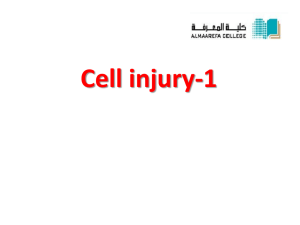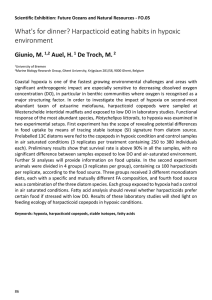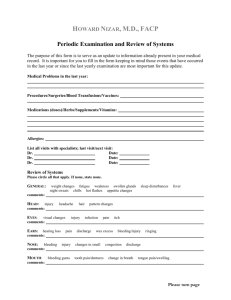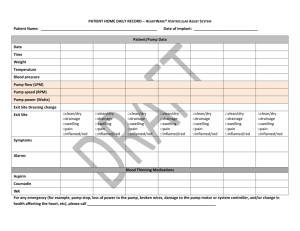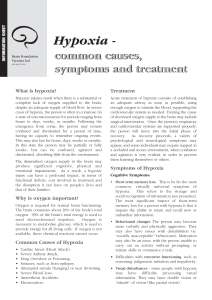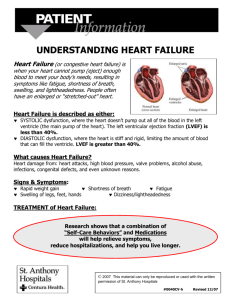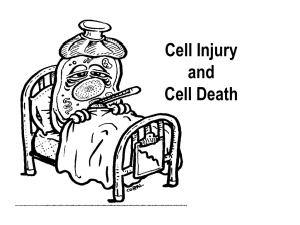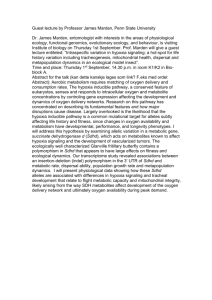Cell Injury
advertisement
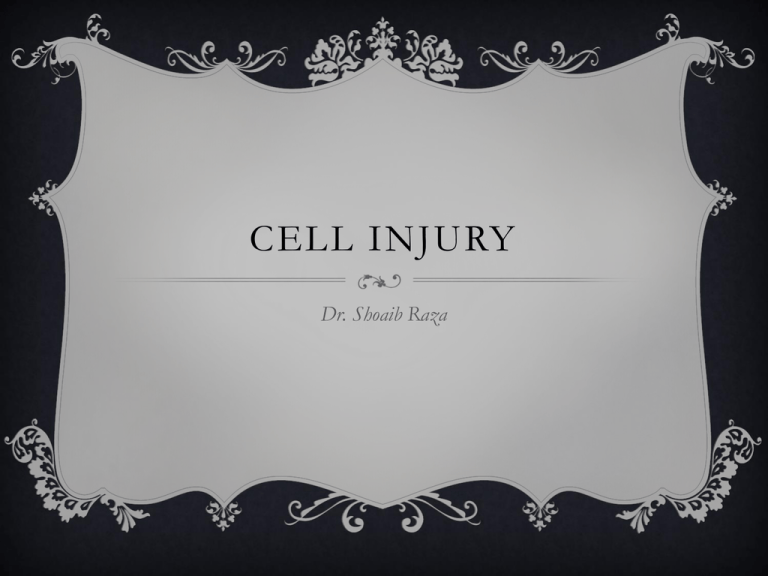
CELL INJURY Dr. Shoaib Raza CELL INJURY When the adaptive capabilities of the cell are exceeded, the cell is said to be injured Abnormal homeostasis • Change in the internal environment of the cell Certain stimulus (triggering agent) is required to produce such change CAUSES OF CELL INJURY Hypoxia is the most frequent cause • Hypoxic hypoxia • High altitude • Ischemic hypoxia • Secondary to ischemia • Anemic hypoxia • Secondary to anemia • Histotoxic (Cytotoxic) hypoxia • Cyanide poisoning CAUSES OF CELL INJURY Nutritional disorders • Deficiency: • Protein Caloric Malnutrition (Kwashiorkor) • Vitamin deficiencies • Beri beri, Scurvy, Anemia, etc. • Excess of nutrition: • Hyperlipidemia • Pick wick disorder • Obesity CAUSES OF CELL INJURY Biological agents: • Infection • • • • • Bacteria Virus Fungi Protozoa Helminths CAUSES OF CELL INJURY Physical agents: • Temperature: • Increased: Thermal injury, syncope • Decreased: Frost bite • Pressure: • Trauma • pH CAUSES OF CELL INJURY Chemical agents: • • • • Corrosive agents Toxins and poisons Drugs Increased or decreased concentration of usual cellular chemicals • Glucose • Oxygen derived free radicals CAUSES OF CELL INJURY Immunological causes: • Immune system provides defense against foreign antigens • Autoimmune disorders: • Immune response against self antigens • Immunodeficiency disorders: • AIDS, Di-George Syndrome, Hyper IgM Syndrome CAUSES OF CELL INJURY Genetic abnormalities: • Mutation • Sickle cell anemia, Thalassemia etc • Chromosomal disorders • Down Syndrome, Klienefelter Syndrome • Other genetic abnormalities CAUSES OF CELL INJURY Aging: • Telomerase activity REVERSIBLE CELL INJURY In early stages or mild forms of injury, the functional and morphological changes are reversible if the stimulus is removed Hallmark features of hypoxic injury are: • • • • ↓ Oxidative phosphorylation ↓ ATP synthesis Cellular swelling Alterations in intracellular organelles HYPOXIA AS A LEADING CAUSE OF CELL INJURY Deficiency of oxygen impairs oxidative phosphorylation, this in turn causes: • Deficient aerobic glycolysis • Anaerobic glycolysis • Accumulation of lactic acid • Reducing pH • Displacement of ribosomes from RER • Clumping of chromatin network • Inactivation of Na + - K+ pump INACTIVATION OF NA + K + PUMP Na+ K+ pump is ATPase dependent, thus ATP deficiency leads to inactivation of Na+ K+ pump Inactivation leads to: • ↑ Na+ influx inside the cell • Intracellular water accumulation • Cell swelling • Swelling of cytoplasmic organelles • Mitochondrial swelling • Lysosomal swelling • ER swelling REVERSIBLE CELL INJURY Due to cellular swelling and impaired function of the cell membrane, certain enzymes (stored in particular cells) are released and their serum levels are raised • Lipase, amylase etc during pancreatic cell injury • CK-MB, LDH etc during myocardial injury • AST, ALT, CPK etc during hepatocellular damage ANY QUESTION?
